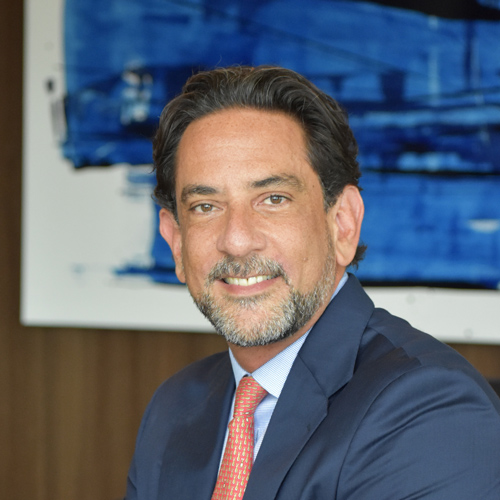
Beatriz Gonzalez Roth took a harrowing ride into New York City in the aftermath of Hurricane Sandy, driving three hours with strangers among downed power lines and broken trees to close a critical deal for Reuters.
Roth began her career as an associate at Patterson Belknap Webb & Tyler in September 1995 after earning a juris doctor from New York University. In 1998, she joined several attorneys assigned to a massive joint venture between the British Broadcasting Corporation (BBC) and Discovery Channel. To get it closed, two days in London turned into a month for Roth, who helped close the transaction that birthed iconic television channels such as Animal Planet and BBC America.
At that moment, the media industry churned under the force of the dot-com boom, but the commercial attorney embraced an opportunity to embed further into the media realm. The career move would not only take her on a wild ride through the historic industry transition, but also empower her to raise a family along the way.
1998: Roth Joins Reuters Group
The Reuters Group sought an attorney who spoke Spanish for a specific role in its legal department, and Roth agreed to an interview. During her summers between earning a bachelor’s degree in political science from the University of Michigan, Roth had returned to her native Miami to work in publishing for several Editorial América magazines, including talk show host Cristina Saralegui’s Cristina: La Revista.
The BBC-Discovery deal Roth had closed in London was still fresh when she met John Reid-Dodick, then US general counsel for the British media and financial information company. “The stars aligned,” Roth says. She recounts the pivotal moment during the interview when he told her: “Wait a minute, you’re a media attorney.”
In this moment of happenstance, Reid-Dodick rejiggered the lineup of interviewers to consider her for Reuters Group’s open position for a media attorney—a domain in which Roth would spend two decades of her career as the face of Reuters expanded and evolved. “I didn’t see it coming,” she says. “They called me because I know Spanish, and they took me because of my media background.”
In May 1998, Roth joined the legal team to support a division then known as a Reuters News Media Inc. “Imagine, it was like a company just called ‘new media’ because the internet was relatively new,” she says. “We had just started selling news to the internet. Forget newspapers, television—those were the established, traditional businesses. I came in to do dot-com sales.”
While the general legal department raced to develop contracts that could keep up with the effects of dot-com innovations, Roth would ensure her career evolved on her own terms.
2000: Roth Starts a Family
The new millennium welcomed enormous growth for the company and Roth’s personal life. A senior colleague noticed Roth wasn’t drinking during the legal team’s global off-site in Rome in 1999 and was the first to guess Roth was pregnant. The colleague turned into a mentor for the mom-to-be, since she herself had been on a nine-month maternity leave when Roth joined the company and had recently returned to work three days
a week.
The young attorney knew her decision to start a family early in her tenure came with the support of Reuters—whose more progressive work-life balance policies, Roth says, may reflect the British-Canadian roots of the company. When she was hired, Roth had been married a few years and knew she wanted children soon. “I was very bold—I asked right up front about the maternity leave policy,” Roth says. “The general counsel gave me a shocking answer, a surprisingly pleasant answer.”
The general counsel cited the example of the very same senior colleague. Roth followed her example, taking an eight-month leave of absence and returning to work four days a week—three days at the New York office and one day working remotely.
During this period of huge change in the media world, Roth often traveled across the multinational enterprise to standardize and globalize practices, which included training lawyers to create internet contracts at a time when the definition of the internet was sometimes necessary. Three years later, she would once again have to redefine her own work-life balance.
2003: Roth’s Family Expands
Roth took a nine-month maternity leave when she gave birth to her second child. But when it came time to return to the office, she knew her schedule was no longer working for her as a mother of two. Once again backed by her Reuters team, now with her former mentor as the US general counsel, Roth reduced her schedule to three workdays—one day in the city and two days working from home.
During various periods in Roth’s life, like when her children first when to school or had busy schedules themselves as teenagers, Roth has been able to shift her work week schedule to fit the needs of her family and the company. “I work part-time, but more importantly, I work flexibly,” she says. “Number one, you have to deliver. You’ve got to bring it. You’ve got to be valuable. You just do it on a truncated schedule.”
“I’m a real believer in the freedom of speech that we have in the United States and the important role of independent news organizations like Reuters in informing the world. That’s why it’s so important for me to do what I do on the business side to continue to fund great reporting.”
—Beatriz Gonzalez roth
Roth explains that there’s no one answer for all. What she needed when her child was a month old isn’t what she needed when her child was ten or fifteen. She advises others to be honest with themselves and their employers about what is and isn’t working. “There’s no harm in asking,” she says. “But when working from home, you really need to communicate that you’re available for calls and emails.”
She understands that remote workers need to set themselves up for success. When Roth’s at her desk at home, she’s solely focused on work. She admits she even habitually walks to a separate room to do anything personal from another computer. (“It’s this weird psychology when I am in my home office,” Roth says.) She recommends proper child care, technology, and designated workspace to help focus on what needs to be done—and during the digital revolution, there was a lot to do at Reuters.
2005-2013: The Implosion of the Media Industry
The one-billionth user went online in late 2005, the Nielsen Norman Group reports, marking a historic shift for the media companies like Reuters. The number of internet users would more than triple within a decade, spurring rampant business reconfigurations to adapt to the digital revolution. The dot-com division at Reuters Group became all media, expanding Roth’s purview.
“That was an era of evolution,” Roth says. “It used to be that the news agency business had very distinct pockets of clients: broadcast television clients, traditional print media clients, and the ever-growing, newer digital market clients. Then those lines became completely blurred.”
That internal consolidation mirrored Reuters’ public trajectory. In April 2008, The Thomson Corporation, a Canadian financial data provider, combined with Reuters Group in a $17 billion deal to form Thomson Reuters in April 2008. After the transaction, the Reuters name only branded the news and media division.
A few years later, around 2013, Thomson Reuters began to unite its editorial operations and the business of media into one organization. Prior, the journalist writing the stories, shooting the videos and taking the pictures operated separately from the colleagues that productized and sold it. Today they have transformed themselves into a single unit under the editor in chief, Stephen Adler, and Roth now reports to Gail Gove, chief counsel for Reuters.
“Honestly, I’m kind of a geek when it comes to the importance of the media,” Roth says. “I’m a real believer in the freedom of speech that we have in the United States and the important role of independent news organizations like Reuters in informing the world. We have journalists in the most dangerous parts of the world, and it’s really quite humbling. That’s why it’s so important for me to do what I do on the business side to continue to fund great reporting.”
2014-2018: Reinventing Media for the Digital Age
Sometimes Roth’s job requires the legal leader to take conference calls in interesting places.
“My philosophy is I never want a deal to suffer because I work part time,” Roth says. “I once did an hour-long negotiation with a major British media company while sitting in my car with my family in the middle of winter with ski gear all around me, and we closed the deal.”
Deals are always ready to be made in the ever-evolving digital platforms. With the last decade’s convergence to mobile, Thomson Reuters launched a mobile video news service, Reuters TV, in 2015. Indeed, the internet changed the legal approach to risk-taking, too.
“Nothing disappears anymore,” Roth says. “We have a lot of control over how our brand is perceived, but I call it the bottle. Once the genie is out of the bottle, you can’t get it back in.”
Today, Roth’s legal team at Reuters continues to tackle the intellectual property issues of the digital age. It spans social media strategy and differentiating editorial from commercial usage in an era when anyone can be a publisher online. Yet the legal team safeguards the 150-year-old news organization’s trusted legacy, and the resurgence of the Reuters’ news brand is ushering in a new era.
“It’s really interesting to now be in a phase when the brand is much more recognized at a time in history when the news has become about the news,” Roth says. “Reuters has emerged as a visible and very important part of the company, not because that’s where the money is—we are small compared to the other business units—but because that’s where the heart of the organization is.”

